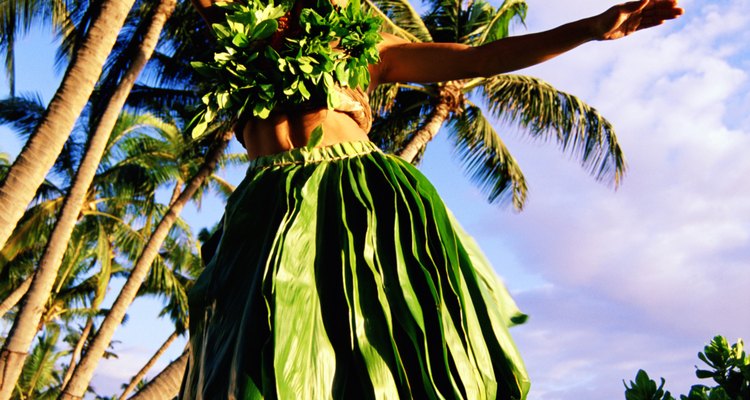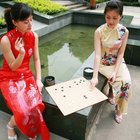
Thinkstock Images/Comstock/Getty Images
The hula is a traditional Hawaiian dance performed to songs or chants that is commonly seen at live performances, festivals and luaus throughout Hawaii. An elegant and entertaining ritual, the hula also conveys specific Hawaiian and Polynesian cultural meanings through movement, as well as costume. This iconic, hip-swaying dance may honor ancient deities, perpetuate myths and legends, or tell stories of everyday life aided by color, texture and styles of dress.
Skirts
Both male and female hula dancers may wear skirts, known as pa`u. Traditionally made of bark cloth, modern hula dance skirts may be made from woven cloth with dyed, painted or silkscreen designs. Skirts are sometimes made using natural native plants and materials, such as dried leaves and processed tree bark. Man-made materials used in skirts include cellophane. Hula auana, or modern hula, utilizes skirts and costumes that are more modern with western-style fabrics and cuts, while hula kahiko, ancient hula, sticks to more traditional garb.
Tops
Ancient Hawaiian dancers usually wore nothing above the waists, but today female dancers usually wear a muumuu, pareau or strapless-style top. Colors used in tops and skirts are often coordinated to reflect the intention of dance. If the dance is performed to honor an ancient water deity, costumes will have a water theme, using blue and green colors and shell accents.
Leis
Leis are made from natural materials, such as shells, nuts, feathers or fragrant plants, such as the fern. Leis may be worn around the neck, around the head or incorporated into hats. The haku lei is one of the most traditional styles of lei consisting of braided foliage on a natural ti leaf base. Kukui nut leis, once only worn by royalty, are another popular style worn by dancers. Fragrant flowers, such as orchids, are sometimes worn in the hair or woven into leis. As well as being decorative and aromatic, the type of material used in the lei may represent specific deities that are being honored in the dance.
Kupe`e
Hand and foot movements play a big role in Hawaiian dance, so wrist and ankle decorations that draw attention to these actions are an important part of hula costumes. Known in Hawaiian as kupe`e, like leis, these adornments are usually made from natural materials. Some of these wristlets and anklets are designed to make sounds to enhance the movements of the dance.
Related Articles

What Do Chinese Women Wear?

Dance Party Theme Ideas

Traditional Chilean Wedding Attire

Ideas for a Bridal Shower With a ...

What Is the Traditional Flamenco ...

Hat Trends of the Seventies

What Is an African Kufi Hat?

How to Make a Tutu Stick Out

How to Make a Swan Lake Headpiece

Things to Put on Top of Your Cake for ...

Quinceanera and Chambelan Outfit Ideas

What Does the Corsage Symbolize?

The Difference Between a Corsage & ...

The History of Satin Fabric

What Does Creative Black Tie Attire ...

What Are Psychedelic Clothes?

Decorating Ideas for a Pavilion for a ...

Roaring '20s Centerpiece Ideas

Hispanic Clothing History

How to Throw an Anime Party
References
Writer Bio
Hilary White is a professional writer and editor based in San Diego. White has been writing articles on fashion, style, fitness, nutrition, movies and entertainment since 1994. Her articles have been published in "Westways" magazine, "Pages" magazine, "Book Street USA," "Magill's Cinema Annual," and numerous titles from Visible Ink Press. White holds a bachelor's degree in English from Michigan State University.
Photo Credits
Thinkstock Images/Comstock/Getty Images